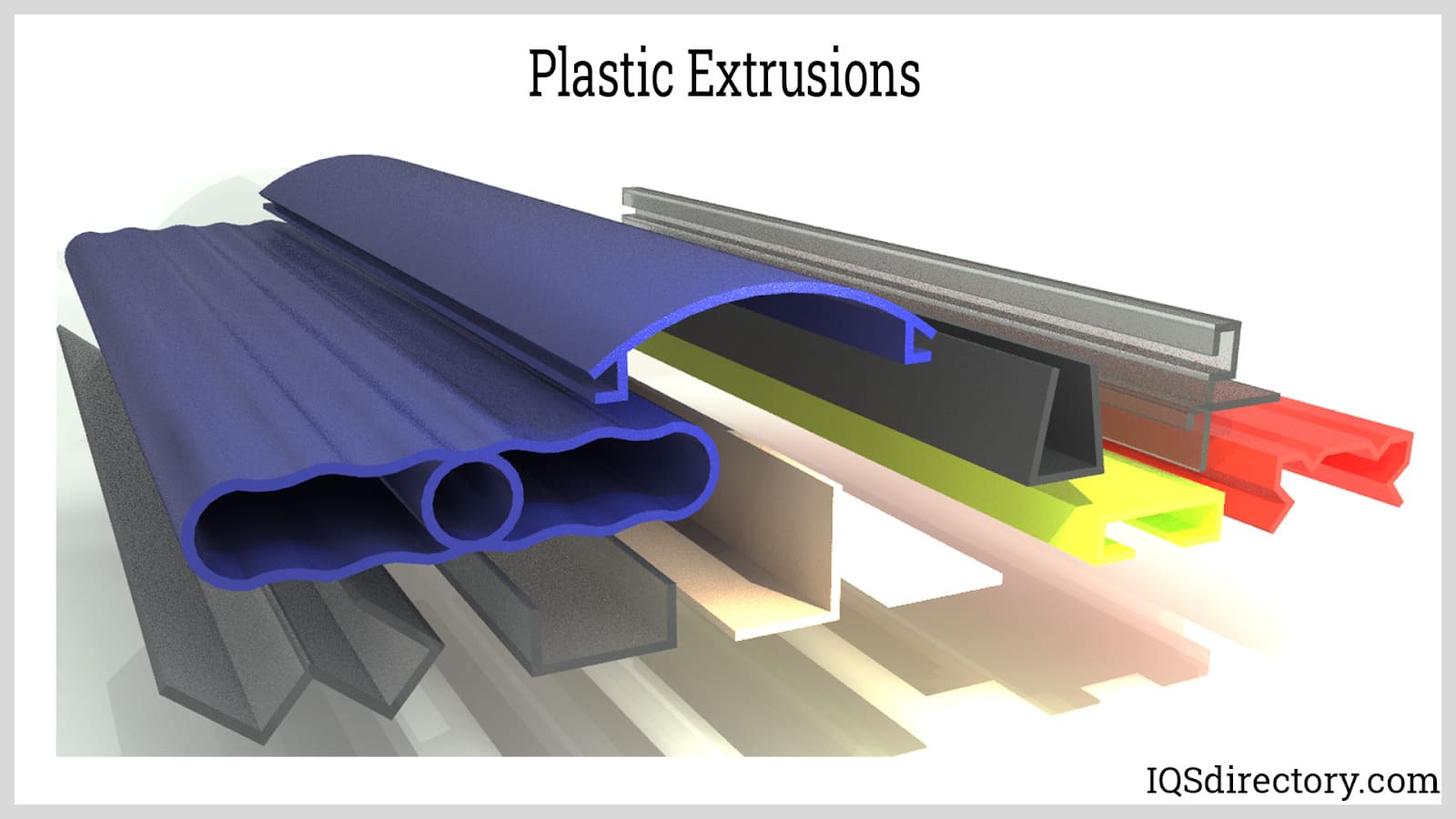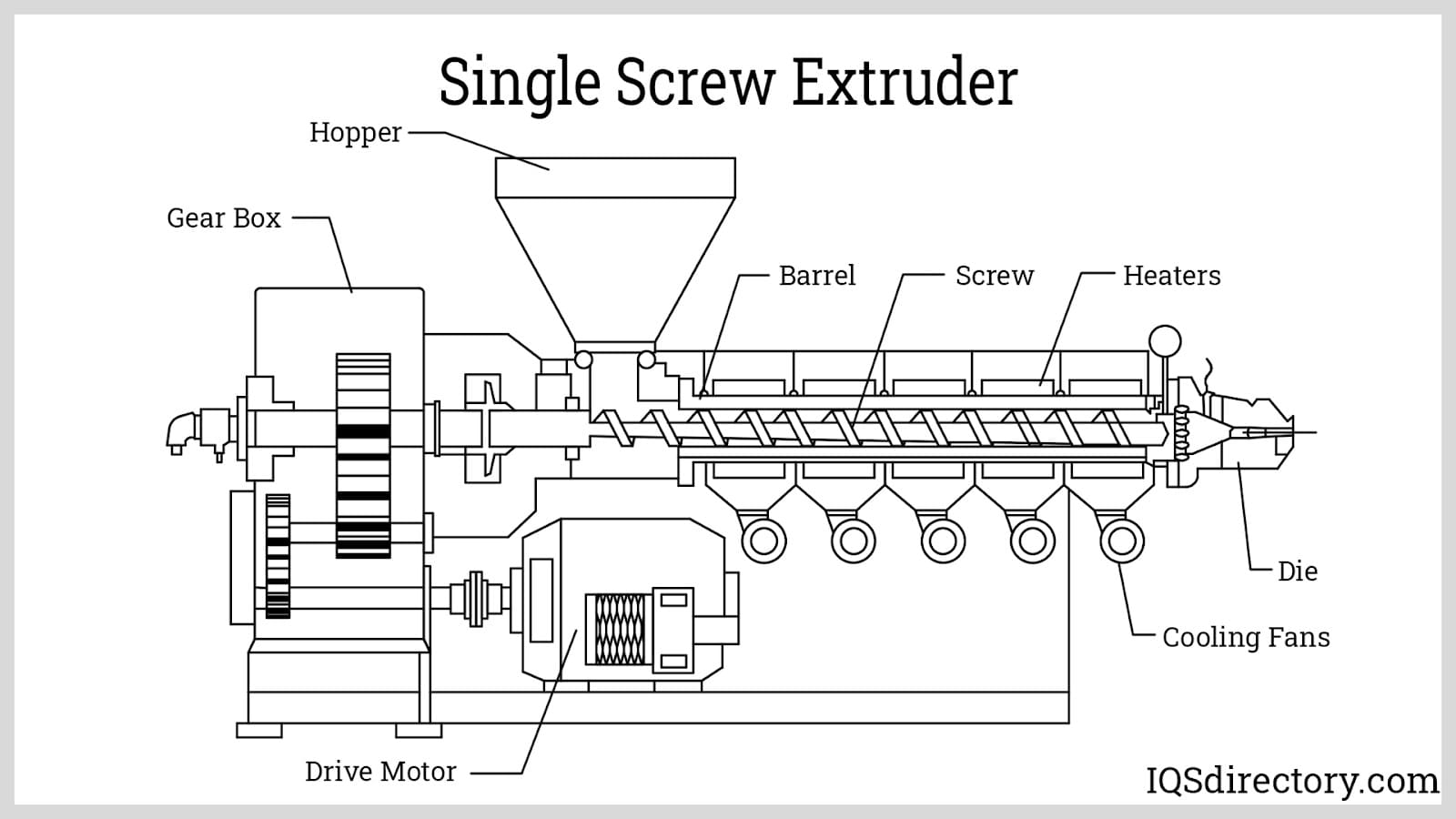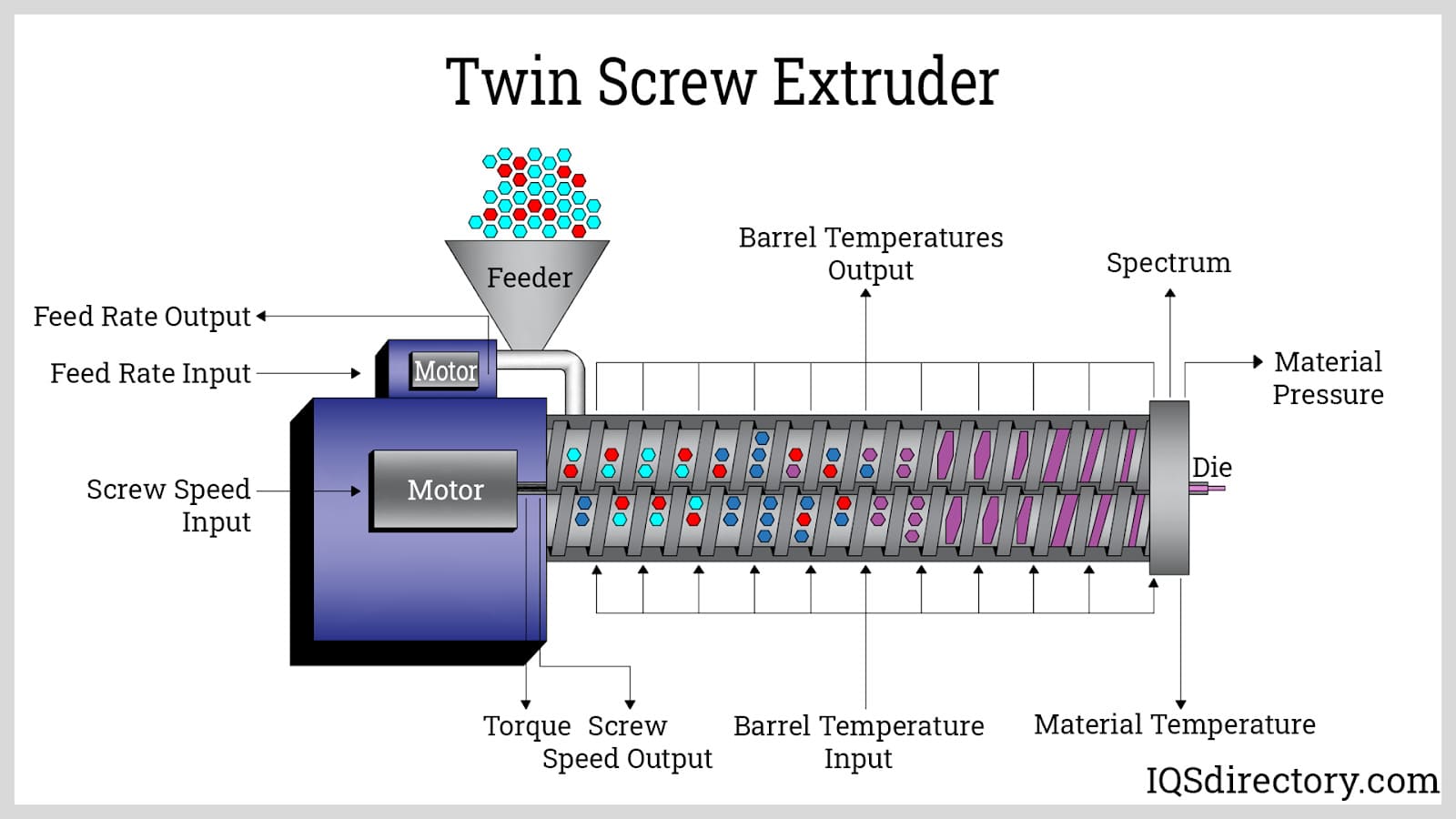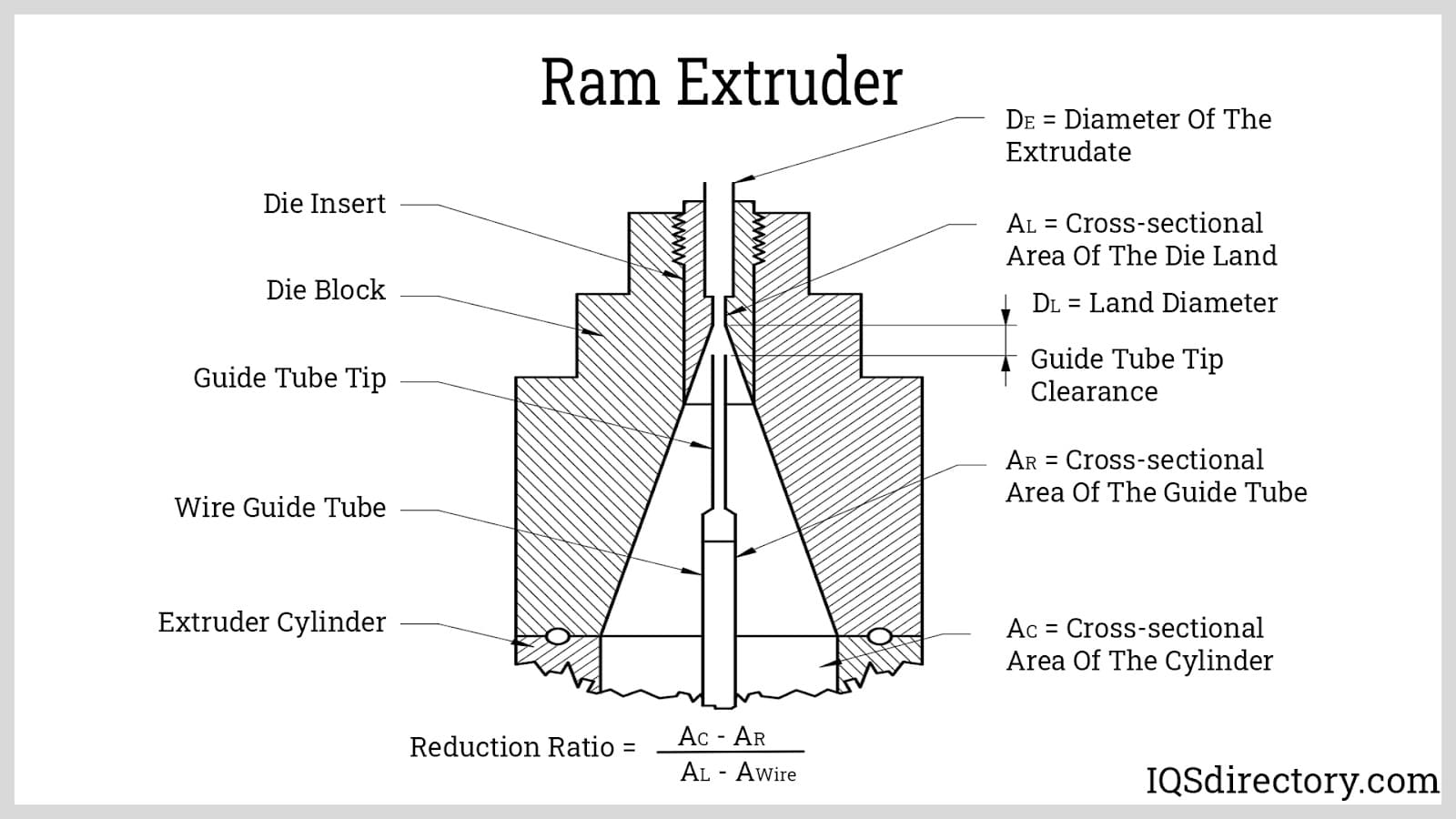Plastic Extrusions
Plastic extrusion is a continuous molding process used to create a diverse range of plastic shapes and products.
While the term polymer extrusion is sometimes used interchangeably with plastic extrusion, it is not the most accurate way to describe the process. Technically, a polymer is a large molecule composed of many similar smaller molecules called monomers. However, when "polymer" and "extrusion" are used together, they specifically refer to elastomers, rubber, and plastic, not the general category of polymers.
Plastic Extrusions FAQ
What is plastic extrusion?
Plastic extrusion is a continuous process where raw thermoplastics are melted and forced through a die to form consistent cross-sectional shapes like tubing, pipes, profiles, or films.
Which industries use plastic extrusions?
Plastic extrusions are used in automotive, construction, HVAC, plumbing, appliances, electronics, food and beverage, and chemical processing, providing durable and cost-effective parts and components.
What products are commonly made through plastic extrusion?
Common extruded products include PVC channels, plastic strips, tubing, medical tubing, window frames, fencing, decking, films, sheeting, coatings, and wire insulation.
What materials are used in plastic extrusion?
Materials include PVC, HDPE, LDPE, PETG, polypropylene, acrylic, polystyrene, butyrate, and other thermoplastics, each chosen based on strength, flexibility, durability, or chemical resistance needs.
How does the plastic extrusion process work?
Raw plastic enters a hopper, is conveyed and melted by a rotating screw, and forced through a die to form a shape. The product is then cooled, hardened, and cut to size for use or further processing.
What are the advantages of plastic extrusion?
Key advantages include high-volume production, low cost, minimal waste, material flexibility, efficiency, and the ability to alter or customize products after extrusion while still warm and malleable.
What is coextrusion in plastics?
Coextrusion combines two or more plastics in multiple layers using separate extruders. This method enhances product performance by merging different material properties into a single extrusion.
Applications of Plastic Extrusion
Plastic extrusion is used to produce a wide variety of products and shapes, serving as a reliable, versatile, and cost-effective solution for many industries. The plastic extrusion process is essential to sectors such as automotive manufacturing, building and construction, HVAC, plumbing, chemical processing, appliances, food and beverage, and electronics.
Plastic Extrusion Products
The plastic extrusion process is used to produce a wide array of plastic components, from engine parts to electronic housings. Other examples of products created through plastic extrusion include PVC channels, plastic strips, profiles, PVC pipes, all-purpose tubing, medical tubing, weather stripping, decorative and functional trim, fencing, deck railings, window frames, plastic films and sheeting, thermoplastic coatings, and wire insulation.
History of Plastic Extrusion
The first versions of the plastic extruder date back to the early 1800s. For example, in 1820, Thomas Hancock invented a rubber "masticator" designed to reclaim processed rubber scraps. A few years later, in 1836, Edwin Chaffee developed a two-roller machine that enabled manufacturers to mix additives into rubber.
Plastic extrusion as we know it didn’t gain significant momentum until the mid-1900s. The first thermoplastic extrusion occurred in Hamburg, Germany in 1935, thanks to Ashley Gershoff and her husband, Paul Troester. Shortly thereafter, Roberto Colombo of LMP in Italy developed the first twin-screw extruders.
Today, the plastic extrusion industry is thriving and expanding, with plastic products increasingly replacing materials like metal and wood. To keep up with growing demand, many plastic extrusion manufacturers have upgraded their facilities for faster production and higher volumes of extrusions. As products become more sophisticated with intricate components, manufacturers are now focusing on precision and the ability to meet exact specifications, even down to the smallest detail.
Materials Used in Plastic Extrusion
- Thermoplastics
- A thermoplastic is a type of plastic material that becomes pliable or moldable when heated, allowing it to be shaped into useful products. Once cooled, the thermoplastic retains its shape. This ability to reshape upon heating is highly valued, especially because thermoplastics can be recycled and reformed through the same process at the end of their lifespan.
- HDPE
- High-density polyethylene (HDPE) is known for its excellent resistance to solvents and corrosion. It boasts high tensile strength, a strong strength-to-density ratio, durability, and overall safety, making it a highly reliable material for a wide range of applications.
- LDPE
- Low-density polyethylene (LDPE) is tough, flexible, and resistant to various acids, alcohols, bases, and esters. It can be extruded in both translucent and opaque forms, offering versatility in manufacturing.
-
- PETG
- Polyethylene terephthalate glycol-modified (PETG), commonly known as polyester, can be used to create rigid or semi-rigid extruded plastic parts. It is lightweight, impact-resistant, and strong, with the added benefit of being a good barrier to gas and alcohol when treated, and a fair barrier to moisture.
- PVC (Vinyl)
- Polyvinyl chloride (PVC), also referred to as vinyl, is the third most widely produced synthetic polymer globally. While it is strong and durable, it requires the addition of a heat stabilizer to maintain stability at higher temperatures. PVC has excellent insulative properties and resistance to acids, fats, alcohols, bases, and salts. PVC extrusions, which includes both rigid and flexible forms, is commonly used for pipes, tubing, flooring, and siding.
- Butyrate
- Butyrate is a polymer modified from cellulose and is known for its transparency, rigidity, and strength. It offers excellent dimensional stability, high impact strength, and is easy to extrude, making it ideal for various applications.
- Polypropylene
- Polypropylene is the second most widely produced synthetic plastic, following polyethylene. It is lightweight, has a low density, and offers high resistance to acids, bases, and chemical solvents. It is also highly thermal-resistant, making it useful for a variety of applications.
- Polystyrene
- Polystyrene is commonly used for containers, cutlery, and packaging. While it is inexpensive to produce, it is environmentally harmful because it degrades slowly and is commonly found as litter in the environment.
- Acrylic
- Acrylic extrusions are known for their optical clarity and durability. Due to these characteristics, acrylic is often used in chemical processing as tubing, where the visibility of contents is crucial for inspection purposes.
Plastic Extrusion Process
The plastic extrusion process is largely standardized, with only a few variations in operation based on material properties. Although operating temperatures and output speeds may differ, the core principles of the extrusion process remain consistent across most applications.
Here’s a breakdown of the typical steps involved in plastic extrusion:
The process begins with raw plastic materials stored in a hopper positioned above a conveyance channel. The materials can be either a single type of plastic or a composite blend.
Once the panel at the bottom of the hopper is opened or retracted, gravity guides the plastic into the channel.
Inside the channel, a long, rotating screw moves the plastic forward. The friction generated by the screw’s rotation causes the plastic to melt. In some extruders, additional electrical heating elements assist in the melting process. By the time the plastic reaches the end of the channel, it is fully molten and ready to be shaped.
The molten plastic is then forced through the extrusion die at the end of the channel, where it takes on the shape determined by the die. The plastic emerges from the die as a newly extruded product.
After leaving the die, the plastic is quickly cooled, which allows it to harden and retain its newly formed shape.
Finally, the extruded plastic is cut to size and either prepared for shipment or sent for further processing, such as labeling, painting, anti-static treatment, or other surface treatments.
Plastic Extrusion Design and Customization
When designing both standard and custom plastic extrusion products, manufacturers take several factors into account, including the optimal material choice, the most suitable manufacturing process, and the appropriate die shape and size. Material selection is determined by aligning the specific requirements of the application with the properties offered by different materials. The chosen manufacturing process—whether hot, cold, or warm extrusion—is selected based on the needs of the application, such as required tolerances, stress, and production volume.
Manufacturers provide a range of custom extrusion options, such as custom profile extrusion, custom tubing extrusion, custom plastic pipe extrusion, and extrusion coating lamination, to meet the diverse needs of various industries.
Machinery Used in Plastic Extrusion
- Extruder
- The extruder consists of several key components: a hopper that holds and heats the material, a conveyance channel through which the molten material is transported toward the die, and a shearing screw that helps to pressurize and push the material through the system.
- Die
-
At the end of the conveyance channel is the die, a specially designed tool used to shape raw materials into finished products. In plastic extrusion, the die is typically a metal plate with a hole through which the molten plastic is forced.
Each die is uniquely designed to suit a specific process. The simplest die designs produce basic shapes— for example, a circular die forms a plastic rod, while a square die creates a continuous square shape. For more complex products like plastic pipes, the die includes special pins to form hollow spaces. Extruders can also produce textured plastic sheets, such as those used for floor mats, by using a flat die with grooves that imprint the texture onto the material.
Plastic Extrusion Images, Diagrams and Visual Concepts
 A continuous high volume manufacturing process in which a thermoplastic material is melted and then forced out of the shaping die with intense pressure.
A continuous high volume manufacturing process in which a thermoplastic material is melted and then forced out of the shaping die with intense pressure.
 The most common continuous extruders.
The most common continuous extruders.
 Twin screw extruders are continuous with multiple screw extruders.
Twin screw extruders are continuous with multiple screw extruders.
 Ram extruders are advantageous in batch operations like injection molding and blow molding.
Ram extruders are advantageous in batch operations like injection molding and blow molding.
Plastic Extrusion Variations and Similar Processes
- Extruding Standard Profiles
- To create a plastic profile extrusion, manufacturers feed resin into a barrel, where it is heated and melted. The molten plastic is then shaped by specialized dies according to the desired specification. For example, to form hollow sections, a mandrel is inserted into the die. For multi-lumen tubes, manufacturers use multiple pins in the die, which create holes as the plastic moves through. In some cases, positive pressure is applied to adjust the size of the lumen and optimize the process.
- Extrusion with Multiple Extruders (Coextrusion)
- Coextrusion is used when plastic needs to be produced in multiple layers. This process combines two or more types of plastic resins, creating a product that incorporates the benefits of each material. To achieve this, manufacturers use multiple extruders that melt the different resins simultaneously, which are then directed into a forked conveyance channel. The materials are combined and fed into a single die where they form the final product.
- Extrusion for Making Plastic Shopping Bags
- Blow film extrusion is the technique used for producing plastic shopping bags and films. This process, similar to standard extrusion, involves a die shaped like a cylinder with an annular opening. The molten plastic is pulled by two rolls, which adjust the thickness of the resin. The die, equipped with an air outlet, blows air into the cylindrical plastic, shaping it. A cooling mechanism, typically a cooling ring, is applied to solidify the film. The thickness of the product is controlled by adjusting the speed of the rolls.
- Extrusion for Making Kernels
- Certain machines produce plastic pellets by extruding various types of resins together. These machines follow the same process as standard extrusion, but instead of producing profiles or tubes, the output is in the form of small beads, which are then used as raw material for further manufacturing processes.
- Extrusion with 3D Printers
- With advancements in 3D printing technology, plastic can now be extruded into complex shapes and structures. 3D printing allows fabricators to create virtually any shape, using filament as feedstock instead of molten resin, providing a new level of flexibility in plastic manufacturing.
- Plastic Injection
- Plastic extruded parts are closely related to injection molded plastics, which are produced using the plastic injection molding process. During this process, plastic pellets are heated until molten in a hopper, and then injected into two hollow cavities. The cavities are clamped together under pressure, and the molten plastic is allowed to cool and solidify. Once solidified, the mold is opened and the plastic product is ejected by a set of ejector rods or pins. Plastic injection molding is ideal for both prototyping and high-volume production, as it can create precise products with tight tolerances.
Benefits of Using Plastic Extrusion
- Efficiency
- Plastic extrusion is known for its high speed, high volume, and low-cost production, making it one of the most efficient methods compared to other molding techniques.
- Low Wastage
- One of the advantages of plastic extrusion is that leftover plastic from trimming or cutting can be reused multiple times, minimizing waste and maximizing material usage.
- Formability
- Plastic's ability to melt easily results in faster production runs and lower energy consumption, contributing to the overall efficiency of the extrusion process.
- Low Cost
- Plastic extrusion is a cost-effective process due to its continuous operation, which helps avoid inventory shortages. The use of inexpensive feedstock, reduced tooling costs, and low disposal expenses all contribute to making this an economical production method.
- Flexibility
- Plastic extrusion offers great flexibility, particularly when products need to maintain consistent cross-sectional profiles. The process can also be easily adjusted to produce plastic sheets or combine different plastic attributes.
- Allows Post-Extrusion Alteration
- After the extrusion process, plastic remains hot and malleable, giving manufacturers the opportunity to make adjustments using various tools such as rollers, shoes, and dies, allowing for additional alterations after the plastic has been formed.
- Versatility
- Plastic extrusion is a highly versatile process, capable of producing parts with complex shapes, varying thicknesses, hardness, sizes, colors, and textures. The key limitation is that the cross-sectional profile must remain consistent throughout the length of the product.
Points to Consider When Using Plastic Extrusion
For optimal performance, it's essential to maintain stable head pressure, ensure consistent temperature at the heating zones, and create a uniform melt flow. Most issues arise from these three critical factors. Below are additional aspects to consider for improving extrusion quality.
- Variations in Concentration of Raw Materials
- The quality of the finished product depends directly on the consistency of the raw materials, from the homogeneity of the molten resin to the final product’s finish. This is particularly crucial for thin gauge extrusion, where process stability is critical, and significant pressure surges (pressure oscillations) can cause issues. While pressure oscillations of ±50 psig are generally acceptable, anything beyond this can negatively impact production. To maintain stable process conditions, it's vital to avoid variations in the concentration of raw materials, especially in terms of mixing virgin and regrind materials.
- Melt-bank Uniformity
- Inconsistent melt bank uniformity can lead to defects such as uneven finishes or irregular polishing patterns. To prevent dull spots on the finished product, it's important to regulate the chrome-roll temperature, keeping it high enough to prevent freezing of the melt bank. Another approach is to shorten the distance between the die lip exit and the primary nipping rolls, ideally between 4 and 8 inches. However, factors such as the die’s size, deckles, and appendages may limit the distance. To address this, the die should be designed with contours that reduce the cross-sectional area.
- Design of Rolls
- When producing thin gauge materials, the rolls must be capable of handling high loads. Special spherical tapered rollers are typically used for this purpose. However, the installation of these rollers also requires adjustments to other components, such as bearing journals and roll shafts, to ensure compatibility and proper functioning within the extruder.
- Roll Deflection
-
Roll deflection is a common challenge faced by fabricators. Three potential solutions exist to address this issue:
- Crowned Rolls – These rolls have a pre-ground camber, which can correct deflection but limits production flexibility, as the camber dimensions and geometry are fixed
- Counter-bending Rolls – This method also addresses deflection but, like crowned rolls, limits the production window due to the fixed nature of the adjustment.
- Roll Skewing – This solution is the most versatile, as it effectively removes deflection across a wide range of operations, offering greater flexibility than the other methods
Choosing the Right Plastic Extrusion Manufacturer
For additional guidance or plastic extrusion services, contact a trusted contract manufacturer. Unsure where to begin? Don’t worry! We’ve made it simple by providing a list of top plastic extrusion companies near the top of the page. The easiest way to find the right manufacturer for your needs is to browse their websites, select a few that align with your needs, and then reach out to ask about your specifications. Pay attention to the one that offers the best customer service. Keep in mind, the right manufacturer will work alongside you to provide cost-effective solutions that meet all your requirements. There’s no reason to settle for anything less than excellent service.
Plastic Extrusion Terms
- Adiabatic Plastic Extrusions
- Plastic extrusions that rely solely on the heat generated by converting drive energy through the viscous resistance of the plastic mass inside the extruder.
- Back Pressure
- The resistance of molten plastic to flow forward in the extrusion process.
- Barrel
- The part of the plastic extruder that encases the screw or plunger mechanism.
- Barrel Liner
- A sleeve that forms the inner surface of the extrusion barrel.
- Calendering
- A process in which plastic material is pressed or smoothed between rollers during extrusion.
- Cladding
- Extruded PVC-U boards used as weather-resistant panels, often referred to as sidings.
- Compound
- A plastic material that has been prepared for further manufacturing processes like extrusion, molding, or calendering.
- Compression Section
- A section of the screw channel in the extruder where the volume of the channel is reduced, typically to create more pressure.
- Cooling Tank
- A tank filled with water that is used to cool the plastic extrusions after they exit the die.
- Cure
- The process of cross-linking a plastic material to enhance its properties.
- Decompression Section
- A section in two-stage plastic extruders where the screw channel volume increases to aid in the cooling and solidifying of the plastic.
- Die
- A specialized tool attached to the plastic extruder head through which the molten plastic is pushed to form the desired shape.
- Die Plate
- The main support for the punch or mold cavity in a die, used for shaping the extrudate.
- Dry Blend
- A mixture of compound or resin and other ingredients, prepared for further manufacturing, especially for plastic extrusion or molding.
- Extrudate
- The product or material that results from the plastic extrusion process, shaped by being forced through a die.
- Extruder Size
- The minimum inner diameter of the plastic extruder barrel.
- Extrusion Coating
- A process in which molten plastic is fed from the extruder dies directly into a nip-roll assembly, which applies the coating to a substrate.
- Haul-off
- An apparatus used to continuously remove extrudate from the die, often called a caterpillar.
- Heat Aging
- The process of exposing thermoplastics or thermoset materials to prolonged heat to evaluate the retention of physical and chemical properties.
- Melt
- The state in which plastic extrusion material is heated to a plastic condition, ready for shaping.
- Melt Strength
- The ability of molten plastic to maintain its structure and form without collapsing during extrusion.
- Outer Die Ring
- Part of the extrusion die that shapes the outer surface of a tube during the extrusion process.
- Pellets
- Small resin beads or tablets, often used in the extrusion process as feedstock, which are melted to form new products.
- Ram Extruder
- An extruder type that uses a plunger to push molten material through the die under controlled temperature conditions.
- Plastic Channels
- Extruded shapes designed to contain, seal, direct, and protect the flow of materials, liquids, or gases.
- Plastic J Channels
- Extruded “J” shaped channels used in construction and displays, often for supporting trim material.
- Plastic Trim
- Linear extruded profiles made from plastic, useful for a variety of applications where products need to be attached, protected, or sealed.
- Resin
- A type of polymerized synthetic or chemically altered natural material, which is used in manufacturing plastics, such as thermoplastics (polyvinyl, polystyrene) or thermosets (epoxies, polyesters).
- Screw
- A rotating helical element inside the extruder barrel that helps move, melt, compress, and homogenize the plastic material.
- Screw Extruder
- A machine with a barrel containing one or more rotating screws that melt and move plastic through the extrusion process.
- Take-up
- A device that reels extruded plastic material for further processing or storage.
- Thermoset
- A type of material that can be melted and formed only once, and cannot be reprocessed after the original product is made.
- Thermoplastic
- Materials such as polyethylene or ABS that can be remelted and reprocessed without significant degradation.
- Torpedo
- An apparatus at the extruder discharge stage that finishes the homogenization and blending of the molten plastic.
- Trunking
- An extruded PVC-U channel used for containing and protecting electrical wires or pipes.
- Vacuum Sizing
- A method of cooling and shaping extrudates by applying vacuum to the outer surface of the plastic.
- Vinyl
- A common term for PVC, which is a type of plastic made from ethylene polymerized into various forms like polyvinyl chloride and polyethylene.
More Plastic Extrusions Information